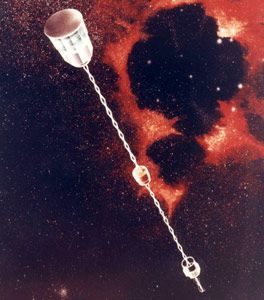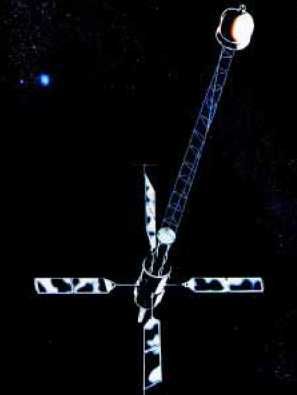TIP (original) (raw)

Home - Search - Browse - Alphabetic Index: 0- 1- 2- 3- 4- 5- 6- 7- 8- 9
A- B- C- D- E- F- G- H- I- J- K- L- M- N- O- P- Q- R- S- T- U- V- W- X- Y- Z
TIP
American navigation satellite.
AKA: Nova;Triad. Status: Operational 1972. First Launch: 1972-09-02. Last Launch: 1988-06-16. Number: 6 . Gross mass: 170 kg (370 lb).
The Transit Improvement Program (TIP) was established in 1969 to test improvements to the Transit Navigation System with the goal of providing a redundant, radiation-hardened satellite that could continue to provide its correct position for over five days without update from the ground. This "drag-free" satellite would use a Disturbance Compensation System (DISCOS) developed at Stanford. Substantial improvements to Transit were demonstrated in the three satellites flown, followed by three production Nova satellites. These evidently were intended to provide ballistic missile submarines with a minimum Transit capability even after a nuclear exchange. However they did not replace the earlier model of Transit satellites, which continued to be launched.
The TIP 150- and 400-MHz transmitters had the output power raised to 3 W at 150 MHz and 5 W at 400 MHz. Each TIP satellite was equipped with a redundant, radiation-hardened, fully programmable minicomputer with 64 KB of memory, a formidable technical accomplishment at the time. To correct for orbital precession over the long life of the Transit satellites, TIP was equipped with a main hydrazine thruster to make orbital corrections as needed to keep the satellite in its polar orbit.
The DISCOS sensor consisted of a mass floating inside a cavity. Small thrusters were automatically fired to keep the floating mass in the middle of the cavity. These thrusters were an innovative pulsed-plasma design developed by Republic Aviation, and used solid Teflon as the fuel. The Teflon was vaporized by an electrical arc, then heated, focused, and expelled by a magnetohydrodynamic bottle. The resulting jet had a specific impulse of 500 seconds, and 1 kg of Teflon, divided between two thrusters, was adequate for ten years of DISCOS operation. Each thruster generated a discrete impulse of 0.38 mN within one second of command.
The TIP satellite also demonstrated a lighter-weight, more accurate oscillator and an improved incremental phase shifter to improve spacecraft timing. A quadrifilar helix antenna of near-ideal configuration was introduced.
In 1977, the Navy awarded a contract to RCA for the production of three Nova spacecraft with the option to build two more. These satellites were nearly identical to the TIP satellites, with minor improvements, including the addition of magnetic damping to DISCOS and a stiffening of the lower boom assembly.
However the basic Transit system had been upgraded in accuracy over the years through improvement of the ground and processing segment and met fleet requirements. Therefore further Nova satellites were not orbited, or only three were needed for the post-strike strategic navigation mission. Instead, six Transits built in the 1960's were orbited two at a time in the late 1980's, and this kept the system in operation until all surface users could convert to GPS and the Transit system was shut down.
Family: Medium earth orbit, Navigation. Country: USA. Spacecraft: Transit. Launch Vehicles: Scout, Scout B, Scout B-1, Scout D-1, Scout G-1, Scout D. Launch Sites: Vandenberg, Vandenberg SLC5. Agency: APL, USN, RCA. Bibliography: 2, 279, 4463, 6.
Photo Gallery
 |
Triad 1Credit: Manufacturer Image |
|---|
 |
Nova 2Credit: Manufacturer Image |
|---|
1972 September 2 - . 17:50 GMT - . Launch Site: Vandenberg. Launch Complex: Vandenberg SLC5. LV Family: Scout. Launch Vehicle: Scout B-1.
- Triad 1 - . Payload: TIP 1. Mass: 94 kg (207 lb). Nation: USA. Agency: USN. Program: Transit. Class: Navigation. Type: Navigation satellite. Spacecraft: TIP. USAF Sat Cat: 6173 . COSPAR: 1972-069A. Apogee: 792 km (492 mi). Perigee: 709 km (440 mi). Inclination: 90.00 deg. Period: 99.80 min. A Scout rocket launched from Vandenberg boosted an improved Navy navigation satellite (TRIAD OI-IX) into orbit. Prototype of improved Transit satellite..
1975 October 12 - . 06:39 GMT - . Launch Site: Vandenberg. Launch Complex: Vandenberg SLC5. LV Family: Scout. Launch Vehicle: Scout D-1.
- Triad 2 - . Payload: TIP 2. Mass: 94 kg (207 lb). Nation: USA. Agency: USN. Program: Transit. Class: Navigation. Type: Navigation satellite. Spacecraft: TIP. Decay Date: 1991-05-26 . USAF Sat Cat: 8361 . COSPAR: 1975-099A. Apogee: 490 km (300 mi). Perigee: 427 km (265 mi). Inclination: 90.40 deg. Period: 93.80 min.
A Scout vehicle carrying a Transit Improvement Program payload was launched from SLC-5, Western Test Range. Launch was successful, but the solar panels of the satellite failed to deploy after the satellite had reached orbit. Prototype of improved Transit satellite. Tested pulsed plasma engine.
1976 September 1 - . 21:14 GMT - . Launch Site: Vandenberg. Launch Complex: Vandenberg SLC5. LV Family: Scout. Launch Vehicle: Scout D-1.
- TIP 3 - . Payload: Triad 3 (TIP 3). Mass: 94 kg (207 lb). Nation: USA. Agency: USN. Program: Transit. Class: Navigation. Type: Navigation satellite. Spacecraft: TIP. Decay Date: 1981-05-30 . USAF Sat Cat: 9403 . COSPAR: 1976-089A. Apogee: 789 km (490 mi). Perigee: 345 km (214 mi). Inclination: 90.30 deg. Period: 95.90 min.
A Scout vehicle carrying a Transit Improvement Program payload was launched from SLC-5, Western Test Range. Launch was successful, but the solar panels of the satellite failed to deploy after the satellite had reached orbit. Prototype of improved Transit satellite. Also tested pulsed plasma engine.
1981 May 15 - . 06:07 GMT - . Launch Site: Vandenberg. Launch Complex: Vandenberg SLC5. LV Family: Scout. Launch Vehicle: Scout G-1.
- Nova 1 - . Mass: 170 kg (370 lb). Nation: USA. Agency: USN. Program: Transit. Class: Navigation. Type: Navigation satellite. Spacecraft: TIP. USAF Sat Cat: 12458 . COSPAR: 1981-044A. Apogee: 1,185 km (736 mi). Perigee: 1,165 km (723 mi). Inclination: 90.20 deg. Period: 108.90 min. Improved Transit..
1984 October 12 - . 01:43 GMT - . Launch Site: Vandenberg. Launch Complex: Vandenberg SLC5. LV Family: Scout. Launch Vehicle: Scout G-1.
- Nova 3 - . Mass: 165 kg (363 lb). Nation: USA. Agency: USN. Program: Transit. Class: Navigation. Type: Navigation satellite. Spacecraft: TIP. USAF Sat Cat: 15362 . COSPAR: 1984-110A. Apogee: 1,200 km (700 mi). Perigee: 1,152 km (715 mi). Inclination: 89.90 deg. Period: 108.90 min. Improved Transit. Pulsed plasma engine..
1988 June 16 - . 06:54 GMT - . Launch Site: Vandenberg. Launch Complex: Vandenberg SLC5. LV Family: Scout. Launch Vehicle: Scout G-1.
- Nova 2 - . Mass: 174 kg (383 lb). Nation: USA. Agency: USN. Program: Transit. Class: Navigation. Type: Navigation satellite. Spacecraft: TIP. USAF Sat Cat: 19223 . COSPAR: 1988-052A. Apogee: 1,198 km (744 mi). Perigee: 1,154 km (717 mi). Inclination: 90.10 deg. Period: 108.90 min. Improved Transit. Pulsed plasma thruster.
Home - Search - Browse - Alphabetic Index: 0- 1- 2- 3- 4- 5- 6- 7- 8- 9
A- B- C- D- E- F- G- H- I- J- K- L- M- N- O- P- Q- R- S- T- U- V- W- X- Y- Z
© 1997-2019 Mark Wade - Contact
© / Conditions for Use
